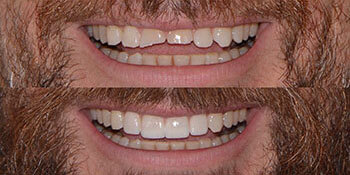Root Canal Treatment Toronto
Endodontic Treatment is an indispensable procedure in the treatment of teeth that are severely decayed, infected, or broken; allowing the affected tooth to be saved from extraction and maintained for many more years.
A root canal is part of a naturally occurring space within a tooth that consists of the pulp chamber, the main canal, and more intricate anatomical branches that may connect the root canals to each other or to the surface of the root. The smaller branches are most frequently found near the root end (apex) but may be encountered anywhere along the root length.
In a root canal procedure, the dentist will access the pulp chamber in the crown of the tooth and will reveal the root canals contained in the roots of the tooth. The infected nerve is removed and the canals are shaped using special files to smooth the walls and ensure no pulp tissue or infection is left. The canals are then filled with a special material that seals off the root canals.
Is Root Canal Treatment painful?
Root canal procedure is not as painful as it sounds! You don't have to dread getting this procedure done. With the help of numbing medicine, you shouldn't have any severe pain. You do have to take good care of your mouth after the treatment, and you may experience some post-procedure discomfort, but nothing that an over the counter pain reliever could not ease.
When do you need Root Canal Treatment?
Once the nerve in a tooth has suffered infection or trauma, the tooth will begin to disintegrate from the inside out. Root Canal procedure preserves the tooth so that it can be retained for several more years rather than needing to be extracted. Endodontic (root canal) treatment is recommended for situations such as:
- Dental abscess
- Dying tooth
- Severe fracture in tooth
- Deep cavities
- Severe tooth sensitivity or pain
Root canal treatment can be done in 1 or 2 appointments. After root canal treatment, your tooth may be tender for the first few days. Severe pain or swelling are not common. If this happens, call your dentist or endodontist. You can still get a cavity or gum disease after a root canal treatment. Root canal treatment does not protect your tooth from other types of damage. However with proper care and regular dental visits, the tooth could last as long as your other teeth. Most of the time, a tooth that has had a root canal treatment can be saved.
Because of the complexity and difficulty of root canal therapy (due to multiple configurations and particularities of root canals in each individual) this treatment can pose a challenge for the dentist. Sometimes, it’s necessary to refer the patient to endodontists specializing in root canal therapy in Toronto.
Why choose us for a root canal treatment?
Getting a root canal treatment can be a scary process. At City Oasis Dental, we do everything in our power to ensure your visit is as comfortable and stress-free as possible. We offer VIP services where we close the clinic to other patients during your appointment, so you can relax without outside pressure.
Dr. Jennifer Lai and her team are extremely professional and have many years of experience serving patients in the Toronto area. Her team has experience in endodontics practice, so you receive high-quality treatment. We’re also more than happy to answer questions you have. Our goal is to maintain the human experience throughout your treatment, so you always feel comfortable and well-taken care of
Why would I need a root canal?
If you have persistent pain, sensitivity to cold or hot temperatures, swollen gums, or tooth discoloration, these symptoms show you might need to visit the dentist for a root canal. Root canals are also needed when you have a cracked tooth from an injury, issues from a previous dental filling, or a deep cavity that can’t be filled.
If you have prolonged decay, it’s best to remove the nerves and tissues that are infected or inflamed to prevent further damage to your tooth and surrounding area.
What happens during the root canal procedure?
During the root canal treatment, the dentist will first clean the root canal. While the infected area is under local anesthesia, the dentist makes a small hole in the surface of your tooth and removes all the infected and dead pulp tissue.
The next step is to fill the root canal. Once the hole is cleaned and shaped using files and solutions, the tooth is filled with a rubber-like material and the canal is completely sealed. Lastly, the dentist will add a crown or filling to protect the surface of the tooth from further infections.
What are the signs you need root canal treatment?
Signs you need root canal treatment include persistent and severe toothaches, prolonged sensitivity to hot and cold temperatures, discoloration, swollen gums, and tenderness in the gums. Other signs include tooth mobility and a chipped or cracked tooth.

